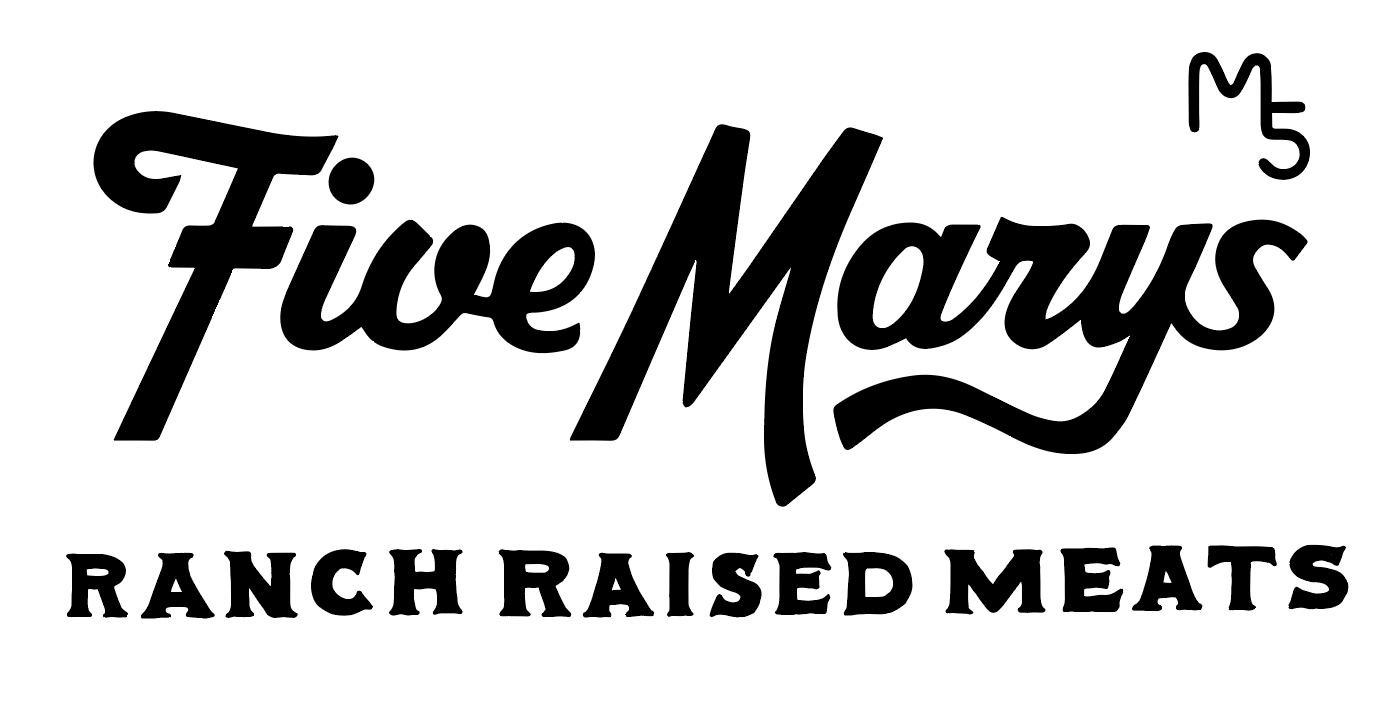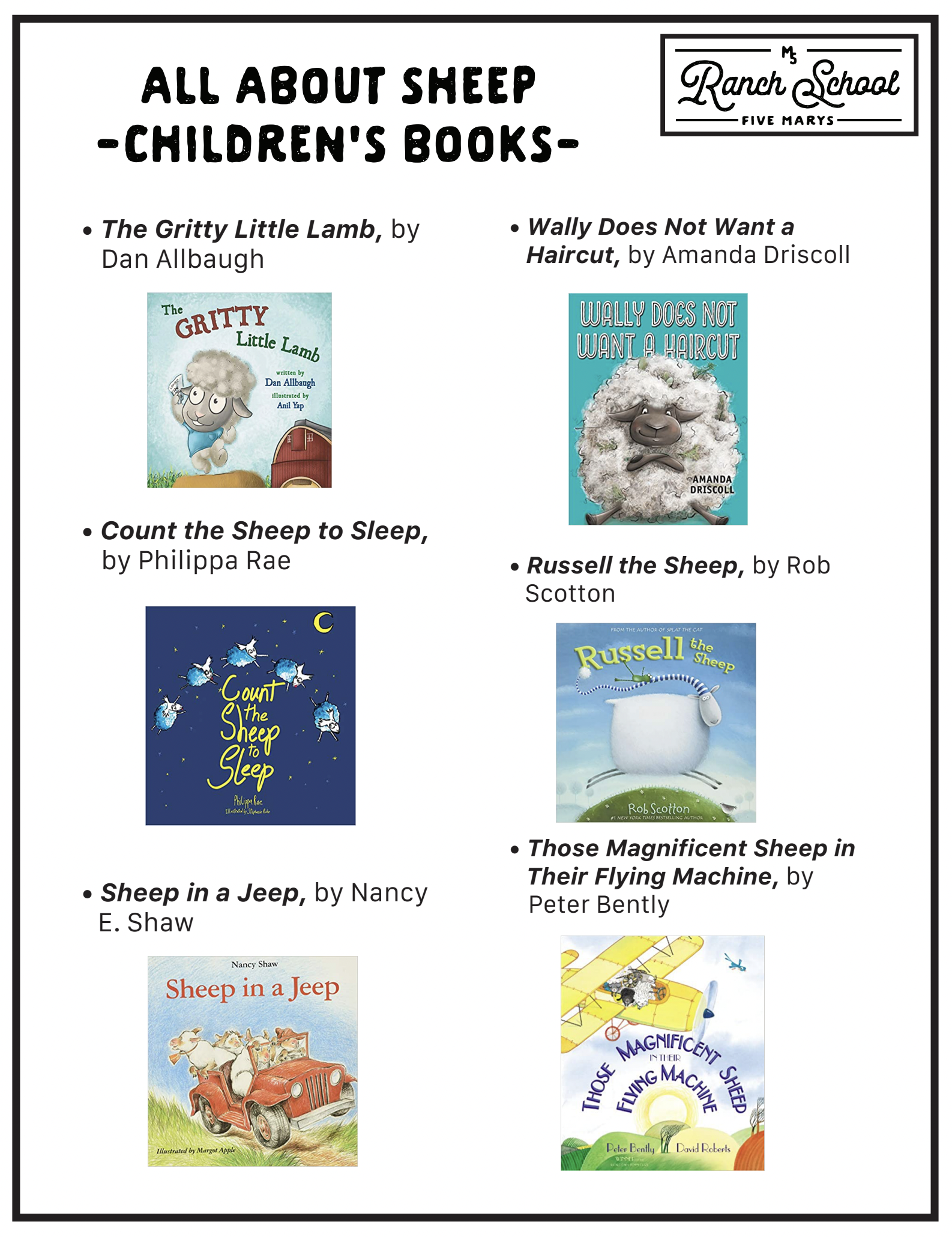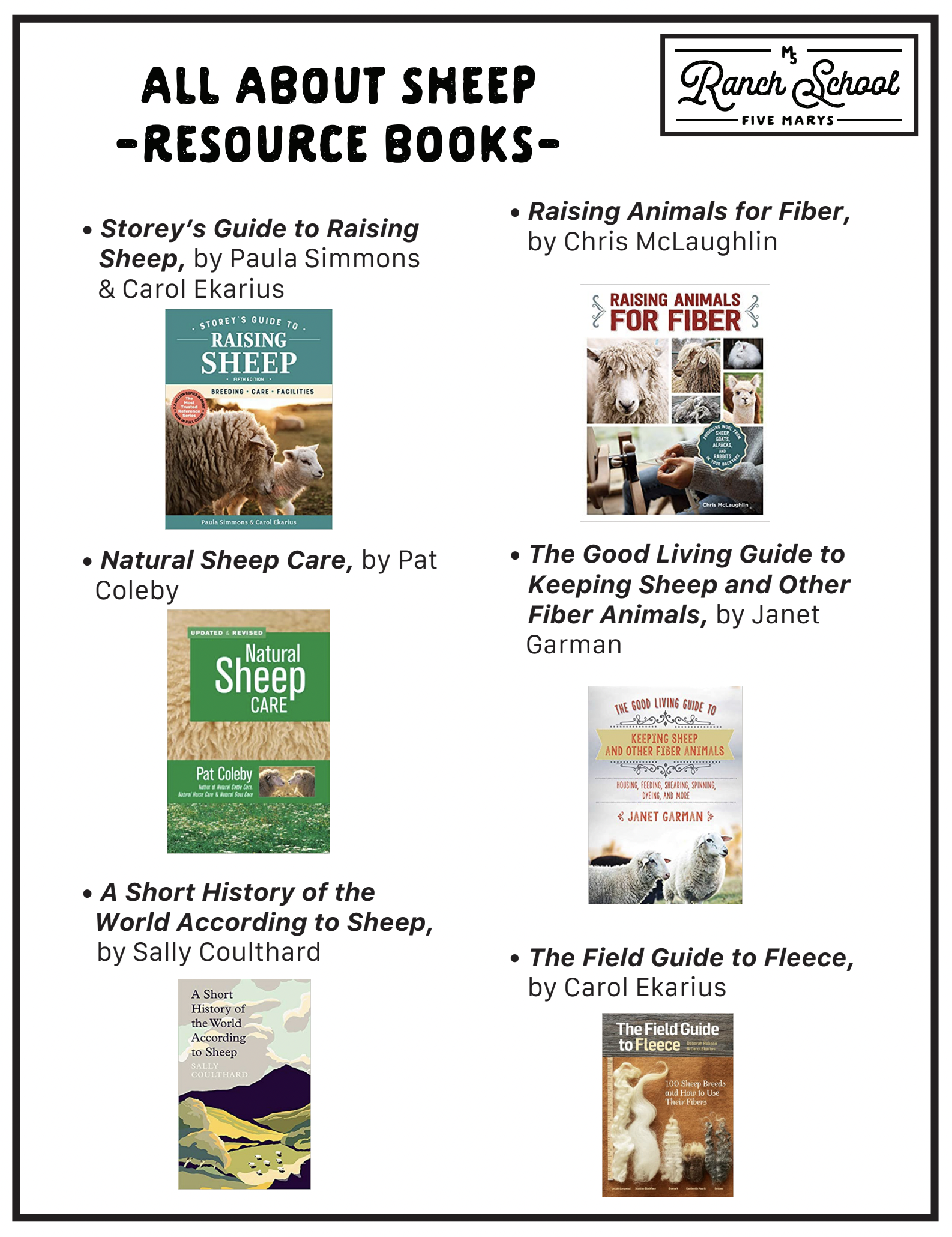M5 Ranch School Lesson: All About Sheep
We often get questions about our M5 Ranch School, so this week, we’d love to share a sample lesson with you!
Welcome to this lesson on sheep! These farm animals have had a long history with humans that has developed over thousands of years. Sheep are not always recognized as being special or intelligent, but this couldn’t be further from the truth. Not only have these animals played a vital role in the development of civilizations, but they have an excellent memory. Their low maintenance care requirements make them a popular, economic animal to raise. Read along to learn more about these intelligent creatures.
Each lesson features a great video on the topic!
We make sure to provide the terms your students’ need:
Sheep Terms
Francie looks at a new black lamb.
Before we get carried away learning about sheep, it is important to have some background vocabulary. Review these sheep terms to help you in this reading.
Ram: an adult, male sheep sometimes called a buck
Ewe: an adult, female sheep sometimes called a yoe
Lamb: a baby sheep
Wether: an adult, male sheep that has been castrated
Gummer: a sheep that is old and has no teeth
Dock: a shortened tail that was cut for health reasons
Flock: a group of sheep
Every lesson includes lots of worksheets. Click to download the PDF!
Need the answers? We also provide an answer key!
Coloring books double as A-Z vocabulary with definitions.
Click the image for the full A-Z vocabulary!
Breeds
There are many popular breeds of sheep throughout the world. Like other farm animals, sheep are bred for a specific purpose: meat, wool, milk, or a combination. Breeds will also be better suited for particular climates. Among the most popular breeds are Dorset, Hampshire, Katahdin, and Suffolk.
A flock of Navajo-Churro sheep at Five Marys Farms being corralled and moved.
Here at Five Marys Farms, we raise Navajo-Churro sheep. This breed is one of the oldest and most popular breeds in the United States. Navajo-Churro are known to produce a very delicious, sweet meat and desirable long fiber wool. This breed was originally introduced to California during the Gold Rush because of demand and their ability to survive off minimal water and foraging. The Navajo-Churro is truly one of the hardiest breeds of sheep today.
Lessons are designed for a wide age range - from preschool to junior high!
Here’s a project designed for older students:
And a worksheet designed for younger students:
Ancient Ancestors
The Wild Mouflon is a breed of wild sheep still living out in eastern Turkey today. They are thought to be the ancient ancestors of domesticated sheep. Mouflon grew a coat of hair that would shed. After domestication for agriculture about 9,000 to 11,000 years ago, sheep began growing a wooly coat that required more maintenance and care. Today, there are a few breeds of hair sheep that continue to have a similar coat to this ancient ancestor. Hair sheep are usually raised for their meat or pelt and tend to be popular since there is no cost to shear them.
A Wild Mouflon sheep roaming the mountains of Turkey.
Fun Fact! Sheep are very intelligent and have a great memory. They are able to create strong relationships and bonds with one another. A ewe and her lamb will be able to identify each other through vocalizations and smells. A grown sheep can remember and recognize other sheep and humans too!
Uses & Products
Being one of the very first domesticated farm animals, sheep have had a long history with humans. Their meat, wool, and milk have played vital roles in the success of many civilizations throughout time.
Each lesson also features a campfire activity video!
Meat
Sheep meat has been and remains a dominant meat source throughout many countries. Both lamb and mutton are types of meat harvested from sheep. Lamb refers to the meat of a sheep under the age of one. It is known for its light, delicate flavor. Mutton refers to meat harvested from sheep older than two years. This meat is more popular in the Middle to Far East for its strong flavor. To this day, lamb and mutton tends to be most popular in countries where sheep were originally domesticated and many traditional recipes call for this delicacy.
Fun Fact! Sheep are like a living lawn mower. They have a special groove in their lips called a philtrum that helps them eat vegetation close to the ground. A group of sheep will clear out an area keeping the vegetation short and well maintained. President Woodrow Wilson even kept a flock of sheep on the White House grounds to cut the cost of lawn care during World War I.
Milk
Along with their meat, sheep milk was considered a staple in many early civilizations that were transitioning from hunting and gathering to farming. For most breeds, milk is a secondary product to their meat or wool, but there are a few breeds that are known as dairy breeds. Feta, pecorino, and Romano are three cheeses that were traditionally made solely from sheep milk.
Wool
Finally, sheep are known for their wool! Wool is different from hair. It is usually lighter and less dense. Wool also has a scaly-surface that allows it to catch on other fibers as they are spun into yarn or pressed into fleece. Wool is also crimped or wavy which leaves space for air and heat to get trapped. This makes wool products, such as sweaters and hats, great for keeping warm in the winter.
The Navajo-Churro have great color variety in their wool.
Depending on the sheep breed, wool can come in great variety and color. The most common color is a creamy white, but some breeds may also produce brown, black, tan, silver, and more. The Navajo-churro here at Five Marys Farms are an example of a breed with great color variety. Other variables include the staple length, density or diameter, and crimp. These factors determine the quality and pricing of wool.
Did you know that wool never stops growing? For this reason, sheep need to be sheared once a year. Most farmers will choose to have their sheep sheared in the spring to prevent them from overheating in the summer. Certain breeds grow their wool so fast that they need to be sheared twice a year!
Fun Fact! A sheep in New Zealand named Shrek once hid in a cave for 6 years because he did not like being sheared. Once he was finally caught, he was in great-need of a haircut. The shearing was aired on New Zealand’s national television. Reports say that he had produced enough wool to make 20 suits!
(Left) Mary jumping into a pile of raw wool. (Right) A freshly shorn sheep exiting the barn.
Lessons also include different writing prompts:
And coloring pages!
Lambing
Now for everyone’s favorite part… the lambs! These baby farm animals are known for being some of the cutest and most fun around the ranch. Ewes have a gestation period of around 5 months. At that point, lambing will begin. A single Ewe will commonly give birth to either one or two lambs at a time. Ewes are known to be good mothers. They will usually take care of both twins. If they ever feel threatened or cornered, they will first send warnings by stomping their hoof. Some may even charge and head butt to protect their young.
It is vital for newborn lambs to get the nutritious, colostrum milk from their mothers. Minutes after birth, lambs will be standing and nursing. If a lamb does not receive this milk, is weak, or left behind, they will need help surviving.
Tessa taking care of Carla, a bottle baby lamb.
Here at Five Marys Farms, these lambs are adopted by the girls as bottle babies. Tessa, JJ, Maisie, and Francie work together to feed the lambs. They keep them dry and warm. The girls also make them bottles using a milk replacement and warm water. Once the lambs are strong enough and foraging for vegetation on their own, they will be reintroduced to the flock.
Fun Fact! Have you ever heard the saying, “they are the black sheep of the family”? It means that the individual is different or unique in some way. This is because black sheep are rare in a flock. They get their color from a recessive gene. They also tend to be born weaker and have a harder time surviving.
Books About Sheep
Lessons provide lots of resources, like suggestions for further reading:
Read Aloud: The Gritty Little Lamb
Most lessons also feature a video of a book on the topic!
Thank you for joining us for this lesson all about sheep! We hope that you learned something new and gained a greater appreciation for these farm animals. If you are left wondering about anything or have anything to share, please let us know. We would love to hear from you!






















